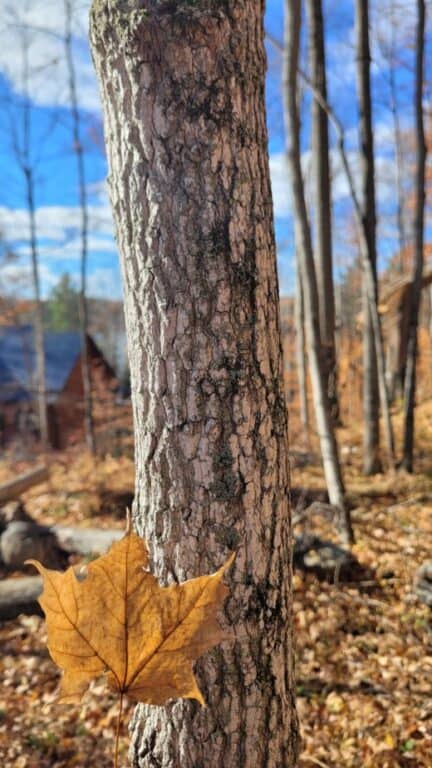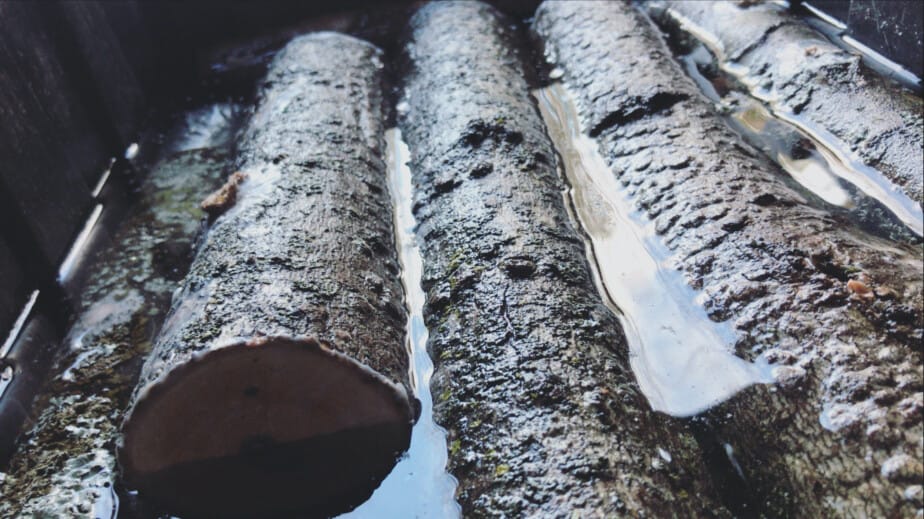This post may contain affiliate links. If you use these links to buy something we may earn a commission. Thanks.
The time it takes to make mushroom logs at home depends on how many hands you have. In this post, you’ll gain insights into how long mushroom logs take to make, and begin producing.
We’ve been making mushroom logs each year for the last few seasons and this time, we timed everything! We thought it would be useful for you to know the time demands of the project you’re getting yourself into.
On average, the total time it takes to make 16 mushroom logs is 7 hours for two people. The time includes sourcing logs, setting up the space, lugging logs around, and actually plugging them. 16 mushroom logs will provide 2 seasonal meals per week for 2-4 people to enjoy.
You’ll get faster with practice and better tools too.
This whole article will be based on 16 logs worth of average time for two people.
For the breakdown of the time, efficient equipment options, and how long it takes to inoculate and colonize the logs—keep reading.
How long does it take to source logs for mushrooms?
The time required to source mushroom logs will involve a good eye, decision-making, and a good back that can carry 20-40 lbs.
On average, it takes 2 hours to find, cut, and move the logs of an appropriate tree for mushroom log making. Finding a healthy tree takes 30 minutes, felling and cutting about 3 small trees with a 4-6″ thick trunk takes one hour, and lugging the logs into a truck takes 30 minutes.
The rest of the time depends on your skill and distance to the workstation.
Finding a healthy tree involves spotting a good size, identifying the tree type you want, determining its health, and deciding how to take it down. In this article, you’ll learn how to identify & select wood for mushroom logs including wood classification and critical log quality checks. You’ll need to know what wood you’re after whether you’re able to fell and cut it up yourself, or will be buying them from someone.

A 4-6″ diameter tree won’t take much time to cut with a chainsaw. To find 16 logs worth of material you might need to fell between 1-3 trees since they all vary in height.
Carefully walking back to the truck through the woods with heavy objects might take a minute or two per log.
How long should mushroom logs be?
We cut all of our mushroom logs to various lengths because they all have various widths.
The average length of a mushroom log is 3.5 feet because it’s a carryable size for the average diameter. Mushroom logs should be a manageable size that you can pick up and carry. Thicker logs will need to be shorter, and thinner logs can easily be longer.
- A healthy 6″ diameter log should be about 3 feet in length
- A healthy 5″ diameter log should be about 3.5 feet in length
- A healthy 4″ diameter log should be about 4 feet in length
You might also notice some wood is lighter than it looks! This can be a sign of dryness from sitting too long or that the wood was already dead before it was cut.
You want your logs to be heavy. Heavy logs are healthy and moist.
How long does it take to set up a mushroom log workstation?
We work on making mushroom logs in the garage. To make the process of plugging logs efficient; we set up several things before we begin.
It takes one hour to set up your mushroom log workstation. You’ll need to gather all materials and tools, then assemble a stable surface for your logs, some heat for your wax, and move the logs to a convenient space nearby.
What items are needed to inoculate mushroom logs?
In the table below, I outline all the items you’ll need for a fully-functioning workstation to inoculate your mushroom logs.
| Item | Function |
| Table or pair of saw horses | Prop up your logs to a comfortable level for drilling, waxing, and labeling. |
| A pair of wedges or short planks | To keep your logs from rolling around (We used two scrap planks on either side) |
| A small candle or portable burner | To keep your wax warm so you can brush each log as needed |
| A rack | To elevate the pot so it sits above the candle |
| A small pot | To contain and heat the wax |
| A paint brush | To apply wax to logs |
| Wax (find food grade) | To seal the logs |
| A drill | To make holes for plugs |
| An adjustable drill depth stop | To make appropriate-sized holes for plugs |
| A mallet | To pound plugs into each hole |
| Wire or twine | To wrap around the logs for a tag/label (twine will need replacing, the wire will last for years of gentle re-use) |
| Duct tape | To attach to the wire/twine to act as a label for a tag |
| A Sharpie | To write on the duct tape so you know the mushroom type |
| Healthy logs | To inoculate with delicious gourmet mushrooms! |
| A space | To put the logs (until you’re ready to put them outside) |
This article was originally published on foodforestliving.com. If it is now published on any other site, it was done without permission from the copyright owner.
If you’re buying mushroom substrate; North Spore also offers several of the tools needed to inoculate logs. QUALITYSPAWN is the current code you can use for a discount on all items.
How long do mushroom plugs last?
Once you get all your materials, the live plugs will have a shelf life. For the first time, we were able to keep our plugs in the fridge for a couple of months before actually using them to inoculate our logs. After that, we’ve been using them pretty quickly. I don’t recall much of a difference.
Most vendors will keep plug spawn fresh enough that they can last 6 months in the fridge when you get them. However, it’s better to use them sooner than later when possible.
If the vendor doesn’t specifically state how to store the plugs when you get them, I suggest you ask! Each vendor may have different production processes and with that, timing.
How long does it take to inoculate logs?
Now that your space is all ready to go, it’s time to use the tools and inoculate the mushrooms by inserting the plugs. Inoculating logs does take some time and patience. With practice, you’ll also get faster.
On average, the total time it takes to inoculate 16 mushroom logs is 4 hours. Each log takes 5 minutes to drill the holes, 3 minutes to hammer the dowels in, and 7 minutes to wax them over.
Inoculating logs is a better breeze when you have the right tools. If you are planning to do multiple seasons of mushroom log making—we recommend a drill bit with a stopper for inoculating logs. Simply because it will waste less time!
Our first time, we wasted over an hour fussing to makeshift our own stopper and trying to be careful not to mess up the depth. If the depth is too little your plugs will protrude. If they are too deep there is less contact with the wood. We recommend an adjustable depth stopper.
If it’s your first time making mushroom logs, it will be the longest time you spend doing it.
Don’t forget to soak your logs for 24-48 hours if they have been sitting for longer than 1-2 weeks from the cut day! This passive time doesn’t count 🙂

How long does mycelium take to fully colonize?
The number of plugs used, the size of the log, and the quality will influence how long it takes to colonize.
In general, it takes 6-24 months for a mushroom log to colonize. Larger logs typically take more time to populate, but the number of plugs used will be somewhat proportionate. When additional plugs get used in lower-quality logs, the timing works within the range since the pros and cons balance.
Some useable logs can have dead or diseased areas, and additional plugs can be drilled around to “fence” the edges, and avoid contaminants from infiltrating further. While the additional plugs may speed colonization, the competition might slow it down—keeping the 6-24 month range intact!
The other factor is the mushroom type. Some mushrooms are more vigorous growers than others. Our turkey tail logs fruited much quicker than shiitakes. Turkey tails are also less picky about temperatures. We have two types of shiitakes, a warmer-loving strain, and a cool-loving strain. They each fruit at different, more specific temperatures. Turkey tails are found almost anytime, anywhere.
Up next:
- How long do mushroom logs last?
- What it Costs to Grow Mushrooms (Indoor vs Outdoor)
- Where to Find Fresh Wood for Mushroom Logs (9 Places)
Recent Posts
There’s no shortage of full-sun ground covers for zone 4 climates! Each plant in this list can withstand the frigid temperatures and also enjoy the hot sun in summer. Full sun means that a plant...
There's no shortage of full sun ground covers, not even in zone 3! Zone 3 climates offer hot but short-lived summers and very cold winters. So each plant in this list can withstand the frigid...
